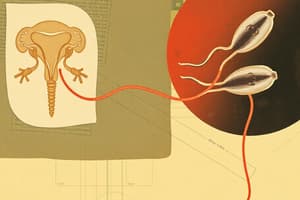Podcast
Questions and Answers
What is the immediate result of the fusion of a sperm cell and an ovum during fertilization?
What is the immediate result of the fusion of a sperm cell and an ovum during fertilization?
Which of the following best describes the process that occurs immediately after fertilization?
Which of the following best describes the process that occurs immediately after fertilization?
In the context of fertilization, what is the primary role of the sperm cell?
In the context of fertilization, what is the primary role of the sperm cell?
Which stage follows after the formation of the zygote during human development?
Which stage follows after the formation of the zygote during human development?
Signup and view all the answers
What is a key characteristic of cleavage that differentiates it from other stages of embryonic development?
What is a key characteristic of cleavage that differentiates it from other stages of embryonic development?
Signup and view all the answers
What is the primary function of the decidua during early pregnancy?
What is the primary function of the decidua during early pregnancy?
Signup and view all the answers
Which statement about decidualization is accurate?
Which statement about decidualization is accurate?
Signup and view all the answers
What is one of the roles of the decidua concerning the placenta?
What is one of the roles of the decidua concerning the placenta?
Signup and view all the answers
How does the decidua influence preterm labor?
How does the decidua influence preterm labor?
Signup and view all the answers
Which of the following best describes a morphological change of the decidua during early pregnancy?
Which of the following best describes a morphological change of the decidua during early pregnancy?
Signup and view all the answers
Which of the following statements best describes the role of decidualization during early pregnancy?
Which of the following statements best describes the role of decidualization during early pregnancy?
Signup and view all the answers
What is a key function associated with the decidua that is crucial for successful pregnancy outcomes?
What is a key function associated with the decidua that is crucial for successful pregnancy outcomes?
Signup and view all the answers
Which morphological change typically occurs in the decidua during mid-pregnancy?
Which morphological change typically occurs in the decidua during mid-pregnancy?
Signup and view all the answers
Which aspect of the decidua is primarily responsible for the interaction with maternal tissues during early pregnancy?
Which aspect of the decidua is primarily responsible for the interaction with maternal tissues during early pregnancy?
Signup and view all the answers
Which of the following statements regarding the prevention of preterm labor is true about the decidua?
Which of the following statements regarding the prevention of preterm labor is true about the decidua?
Signup and view all the answers
Study Notes
Fertilization
- Fertilization is the fusion of a sperm cell from a male and an ovum (egg) from a female, creating a zygote. It's crucial for sexual reproduction and initiates embryonic development.
Sperm Transport
- After ejaculation, sperm travel through the female reproductive tract (cervix, uterus, fallopian tubes).
- Capacitation is a process sperm undergo to gain the ability to fertilize the egg. Biochemical changes in their plasma membrane are involved.
Interaction with the Egg
- The egg is surrounded by layers: the corona radiata (granulosa cells) and the zona pellucida (glycoprotein layer).
- Sperm must penetrate these layers to reach the egg's plasma membrane.
- Acrosome Reaction: Enzymes are released from the sperm's head to digest the zona pellucida.
- Sperm Binding: Sperm bind to specific receptors on the egg's surface after penetrating the zona pellucida.
Fusion of Sperm and Egg
- Membrane Fusion: Sperm and egg plasma membranes fuse, allowing the sperm nucleus to enter the egg.
- Cortical Reaction: The egg releases enzymes that modify the zona pellucida, preventing polyspermy (multiple sperm from entering).
Formation of the Zygote
- After fusion, the sperm and egg nuclei combine, creating a diploid zygote with a full set of chromosomes (typically 46 in humans).
- The zygote travels down the fallopian tube to the uterus, preparing for implantation.
Cleavage
- Cleavage is a series of rapid mitotic divisions of the zygote immediately after fertilization.
- Blastomeres are smaller cells formed during cleavage. Results in a blastula (multicellular structure)
Stages of Cleavage
- Two-Cell Stage: Zygote divided into two equal-sized cells (approximately 24-30 hours after fertilization).
- Four-Cell Stage: Two subsequent division (48 hours post-fertilization), marking beginning of cleavage process. Cells within the zona pellucida.
- Eight-Cell Stage: Further division (72 hours after fertilization) creating eight blastomeres.
- 16-Cell Stage (Morula): Structure becomes a solid ball (morula) of 16+ cells. Continues to divide.
- Blastocyst Formation: Fluid accumulates, forming a cavity (blastocoel), transforming the morula into a blastocyst. -Inner Cell Mass (ICM): Cells that will become the embryo. -Trophoblast: Outer layer contributing to forming the placenta.
Implantation of the Blastocyst
- After 5-6 days post-fertilization, the blastocyst reaches the uterus and adheres to the uterine lining.
- Trophoblast invades the endometrium, establishing implantation and nutrient exchange.
Studying That Suits You
Use AI to generate personalized quizzes and flashcards to suit your learning preferences.
Description
Explore the fascinating process of fertilization, including sperm transport and the interaction between sperm and egg. This quiz covers the critical stages from sperm journey through the female reproductive tract to the fusion of sperm and egg, detailing important physiological changes and mechanisms involved.



